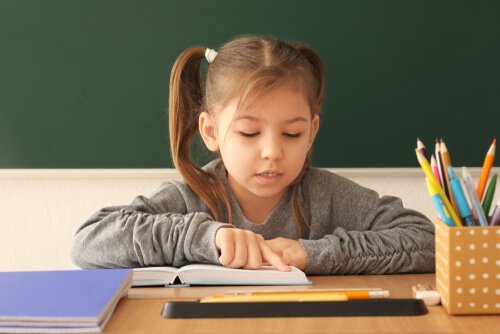7 Strategies to Improve Reading Comprehension


Written and verified by the psychologist María Alejandra Castro Arbeláez
It’s fundamental to improve reading comprehension in children for their academic development. When kids don’t understand what they read, they can feel frustrated doing this very important activity. By this, we mean the ability to read a sentence or text, make sense of the words, and understand the overall meaning.
“Although kids start to approach literacy in preschool, they really learn about it in the first year of primary education. Every student will have more or less developed abilities, rhythms and needs. Therefore, teachers need to learn to respond to all of them.”
If you wonder why your child has poor school performance or has problems in certain subjects, it’s important to check his or her reading ability. Luckily, you can reinforce and improve it at home with the help of teachers.
With the right strategies, you can learn to build concepts and navigate through reading levels. For example, you can help your child learn literal, inferential and critical reading.
How to improve reading comprehension in children
1. Establish connections and relationships
When you read with your child, show him that the concepts connect to his real life. In fact, one of the best tricks to remember what you read and make it valuable is to see that they have an application.
First of all, ask your child to identify these relationships verbally. Then, he can do it silently and in a more fun and independent way.

2. Ask questions to understand texts
If you ask your child questions about the information in the text, you are teaching him to look for clues. Motivate him to interact with the text and choose information that’s relevant to him.
One of the characteristics of a good reader is the ability to ask questions and find the answers. They can use one text or other sources too.
3. Create mental images that facilitate reading comprehension
Texts aren’t just papers full of letters; they’re universes to discover and explore. Have your children imagine and recreate the stories using their imagination so they remember them better.
A good resource for this is to ask children to draw the contexts and concepts how they see them. Not only do they read through their eyes, but they remember with all five senses.
4. Propose hypotheses about what you read to improve reading comprehension
The literal level of texts is the information on the page. You can explore it through exact questions and answers. However, there’s a second level of understanding that invites kids to think about the consequences of a situation.
On the other hand, they can think about causes of a problem. Ask your children what they think will happen next in the book they’re reading.
5. Identify the main ideas and elements
It’s important for kids to be able to identify the main ideas of what they’re reading. That is, the facts and characters that directly influence the development of the story.
In this sense, it’s good to give them different genres. In addition to non-fiction, give them fiction and adventure stories. This way, they’ll learn to identify textural markers like titles, bold letters, italics, images and tables of contents.
Other tips to improve reading comprehension in children
6. Reread parts you don’t understand
You might not understand everything the first time you read something. Often, you’ll need to read the same part a few times to fully understand it.
Additionally, every time you read, you learn more details that help you understand the passage. In fact, sometimes it’s better to do it quietly, and sometimes it’s better out loud.

7. Check for unknown words
It’s not possible to understand a reading completely if there are lots of words that you don’t understand. Additionally, looking up definitions and using context clues can help improve kids’ vocabularies. Dedicated readers also have the ability to play with definitions in their own writing.
Finally, as you can see after reading this article, strategies to improve reading comprehension in children strengthen all of children’s communicative and cognitive abilities. In fact, you can help children at home to be more successful at school. In addition, they can learn to develop critical thinking when reading.
It’s fundamental to improve reading comprehension in children for their academic development. When kids don’t understand what they read, they can feel frustrated doing this very important activity. By this, we mean the ability to read a sentence or text, make sense of the words, and understand the overall meaning.
“Although kids start to approach literacy in preschool, they really learn about it in the first year of primary education. Every student will have more or less developed abilities, rhythms and needs. Therefore, teachers need to learn to respond to all of them.”
If you wonder why your child has poor school performance or has problems in certain subjects, it’s important to check his or her reading ability. Luckily, you can reinforce and improve it at home with the help of teachers.
With the right strategies, you can learn to build concepts and navigate through reading levels. For example, you can help your child learn literal, inferential and critical reading.
How to improve reading comprehension in children
1. Establish connections and relationships
When you read with your child, show him that the concepts connect to his real life. In fact, one of the best tricks to remember what you read and make it valuable is to see that they have an application.
First of all, ask your child to identify these relationships verbally. Then, he can do it silently and in a more fun and independent way.

2. Ask questions to understand texts
If you ask your child questions about the information in the text, you are teaching him to look for clues. Motivate him to interact with the text and choose information that’s relevant to him.
One of the characteristics of a good reader is the ability to ask questions and find the answers. They can use one text or other sources too.
3. Create mental images that facilitate reading comprehension
Texts aren’t just papers full of letters; they’re universes to discover and explore. Have your children imagine and recreate the stories using their imagination so they remember them better.
A good resource for this is to ask children to draw the contexts and concepts how they see them. Not only do they read through their eyes, but they remember with all five senses.
4. Propose hypotheses about what you read to improve reading comprehension
The literal level of texts is the information on the page. You can explore it through exact questions and answers. However, there’s a second level of understanding that invites kids to think about the consequences of a situation.
On the other hand, they can think about causes of a problem. Ask your children what they think will happen next in the book they’re reading.
5. Identify the main ideas and elements
It’s important for kids to be able to identify the main ideas of what they’re reading. That is, the facts and characters that directly influence the development of the story.
In this sense, it’s good to give them different genres. In addition to non-fiction, give them fiction and adventure stories. This way, they’ll learn to identify textural markers like titles, bold letters, italics, images and tables of contents.
Other tips to improve reading comprehension in children
6. Reread parts you don’t understand
You might not understand everything the first time you read something. Often, you’ll need to read the same part a few times to fully understand it.
Additionally, every time you read, you learn more details that help you understand the passage. In fact, sometimes it’s better to do it quietly, and sometimes it’s better out loud.

7. Check for unknown words
It’s not possible to understand a reading completely if there are lots of words that you don’t understand. Additionally, looking up definitions and using context clues can help improve kids’ vocabularies. Dedicated readers also have the ability to play with definitions in their own writing.
Finally, as you can see after reading this article, strategies to improve reading comprehension in children strengthen all of children’s communicative and cognitive abilities. In fact, you can help children at home to be more successful at school. In addition, they can learn to develop critical thinking when reading.
All cited sources were thoroughly reviewed by our team to ensure their quality, reliability, currency, and validity. The bibliography of this article was considered reliable and of academic or scientific accuracy.
- Córdoba Rey, E. M., Cadavid Ruíz, N., & Quijano Martínez, M. C. (2015). Hábitos y expectativas lectoras de padres de niños con dificultad lectora. CES Psicología, 8(2), 31-46. http://www.scielo.org.co/scielo.php?script=sci_arttext&pid=S2011-30802015000200003
- Cova, Y. (2004). La práctica de la lectura en voz alta en el hogar y en la escuela a favor de niños y niñas. Sapiens. Revista Universitaria de Investigación, 5(2), 53-66. https://www.redalyc.org/pdf/410/41050205.pdf
- Díaz, J. Q., & Domingo, B. G. (2008). Aproximación didáctica al tratamiento que recibe la lectura en el aula de Infantil y Primaria. In Educación, ciudadanía y convivencia. Diversidad y sentido social de la educación: comunicaciones del XIV Congreso Nacional y III Iberoamericano de Pedagogía (pp. 1095-1104). Sociedad Española de Pedagogía.
- Fonseca, L., Migliardo, G., Simian, M., Olmos, R., & León, J. A. (2019). Estrategias para mejorar la comprensión lectora: impacto de un programa de intervención en español. Educational Psychology, 25(2), 91-99. https://journals.copmadrid.org/psed/art/psed2019a1
- Monroy Romero, J. A., & Gómez López, B. E. (2009). Comprensión lectora. Revista Mexicana de Orientación Educativa, 6(16), 37-42. http://pepsic.bvsalud.org/scielo.php?script=sci_arttext&pid=S1665-75272009000100008
- Palomino, J. G. (2011). Comprensión lectora y rendimiento escolar: una ruta para mejorar la comunicación. COMUNI@ CCIÓN: Revista de Investigación en Comunicación y Desarrollo, 2(2), 27-36. https://www.redalyc.org/pdf/4498/449845038003.pdf
- Raynaudo, G. M. (2020). Educar en el mundo digital: Un estudio empírico con niños preescolares. https://ri.conicet.gov.ar/handle/11336/155689
- Sanz, M., & León, J. A. (2010). Estimular la comprensión lectora. Padres y Maestros/Journal of Parents and Teachers, (333), 25-29.
- Serrano-Puche, J. (2014). Hacia una “comunicación slow”: el hábito de la desconexión digital periódica como elemento de alfabetización mediática. Trípodos, (34), 201-214. http://www.tripodos.com/index.php/Facultat_Comunicacio_Blanquerna/article/view/172
This text is provided for informational purposes only and does not replace consultation with a professional. If in doubt, consult your specialist.








